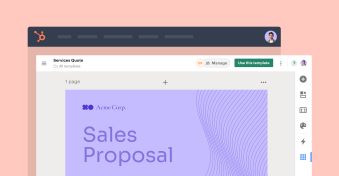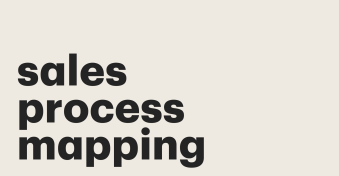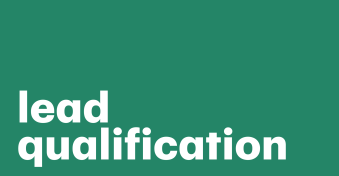What is B2B sales, and what strategies can you use to maximize your success?
Whether you’re a B2B-native startup or an established direct-to-consumer company pivoting to B2B sales, this guide will walk you through everything you need to know about B2B.
From the benefits and types of B2B sales to key best practices, strategies, and more, let’s dive into the world of business-to-business selling.
Key takeaways
- B2B sales models drive benefits like increased brand awareness, customer loyalty, reliable revenue, and higher average order value.
- The B2B sales process involves several key stages: prospecting, qualifying, connecting, pitching, and closing.
- Implement key strategies like account-based selling, content marketing, and social selling.
- Utilize B2B sales metrics to track success and improve your sales strategy.
- Embrace technology and resources to automate and streamline your sales process.
What is B2B sales?
First things first: how do we define B2B sales? B2B sales, or business-to-business sales, describe the complex process of delivering products, services, or SaaS to another business.
In other words, it’s when a business sells to a company rather than an individual consumer.
Compared to B2C (business-to-customer) selling, B2B selling is much more complex.
It involves unique activities like in-depth company research, cold calling and emailing, face-to-face communications, sales demos, and contractual agreements.
Why is B2B sales important?
When salespeople aren’t given clear direction, it can stall sales and stunt business growth.
A B2B sales strategy presents salespeople with a roadmap to success, outlining the approach, techniques, and tactics that successfully drive prospects to conversion.
4 benefits of B2B sales
Is expanding into B2B sales worth it? The answer very much depends on your specific industry, customer base, and product/service.
But there’s no denying that B2B sales can unlock lucrative opportunities, regardless of whether you fully, or partially, expand into B2B.
Here are 4 standout benefits:
- Higher average order values (AOV): B2B customers buy in large quantities rather than single units, drastically boosting your AOV and revenue.
- Customer loyalty: B2B customers boast high customer lifetime values. They make consistent purchases and refer your brand to others. Sales professionals surveyed by HubSpot in their State of Sales report revealed that 33% of their high-quality leads came from referrals from existing customers.
- Reliable revenue: Because B2B buyers aren’t as fickle as B2C buyers, you can rely on them to make regular orders, generating predictable revenue.
- Boosted brand awareness: Expanding into B2B introduces you to a whole new market. You can reach customers via new channels, such as Linkedin, wholesale marketplaces, and industry events.
What are examples of B2B sales?
B2B sales vary depending on the industry and the type of product or service that you’re selling.
Generally, though, we can split them into three categories.
So, what are the three main types of B2B sales?
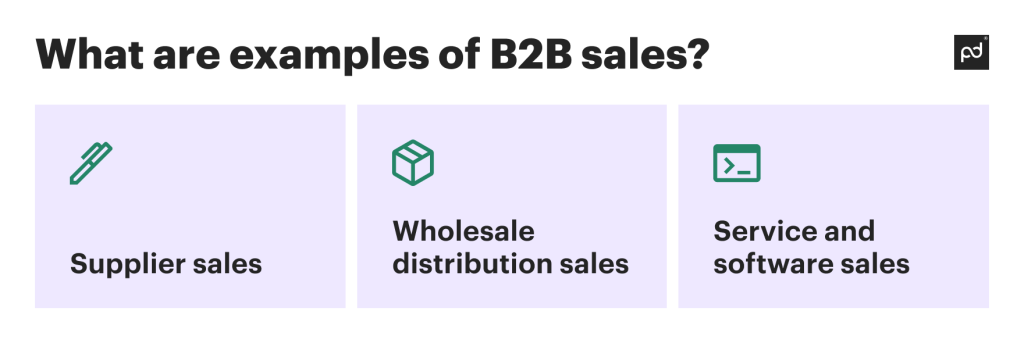
Supplier sales
B2B companies that partake in supplier sales sell operational consumables to other businesses.
This includes everything from office supplies, like pens, paper, and printers, to heavy-duty equipment like trucks and concrete mixers.
Unlike B2C, B2B supplier sales are made in large quantities.
For example, a B2B company might sell 20 printers to a law firm or 50 trucks to a construction company.
Wholesale distribution sales
B2B wholesalers sell bulk raw materials to other businesses or retailers for a discounted price.
They usually act as the middle-man between the manufacturer and the retailer.
Take wholesale food distributors, for example.
Sysco, the largest food distributor in the U.S., purchases food directly from the manufacturer.
These ingredients are then sold in large quantities to restaurants, fast food outlets, and hotels.
Service and software sales
In the digital era, software and service sales make up a significant chunk of B2B sales models.
A B2B company can sell its software-as-a-service (SaaS) tools as well as its professional expertise to other businesses.
For example, an SEO agency might sell its services to businesses looking to increase their organic traffic.
The agency might perform services like keyword research, technical audits, and content optimization.
B2B marketing automation is one of the main SaaS offerings that you’ll come across.
PandaDoc, for example, provides document automation software that helps businesses create efficient document workflows.
What’s the difference between B2B sales and B2C sales?
The overarching difference between B2B and B2C sales is their target customer.
Business-to-consumer (B2C) companies sell directly to consumers. B2B companies sell exclusively to other businesses.
This brings about several key differences between the B2C and B2B sales processes.
Let’s cover some of the main ones:
Sales cycle length and complexity
While B2C customers can make spontaneous, impulsive purchases, B2B purchases are made strategically to reduce financial risk.
As a result, the B2B sales process is much more complex and lengthy.
It involves long-term relationship-building, establishing trust, identifying complex needs to determine provider/product fit, proposal development, and negotiations.
Number of decision-makers
For a B2B purchase to go ahead, it needs to be approved by several decision-makers.
So, B2B companies often communicate with stakeholders across an organizational hierarchy, from high-level executives to managers.
This is in stark contrast to B2C purchases, where the purchasing power tends to lie with one or two individuals.
Decision-making factors
70% of B2C buying decisions are driven by emotion, according to Gallup. But the same can’t be said for B2B.
B2B buying decisions are based primarily on logic.
So, instead of emotionally charged storytelling, B2B companies must present customers with the facts they need to make informed decisions.
This includes statistics, in-depth case studies, B2B webinars, white papers, and product demos.
What is a B2B sales representative?
B2B sales representatives seek, build, and nurture relationships with corporate stakeholders with the end goal of selling them a product or service.
They can be split up into two different types: B2B outside sales reps and B2B inside sales reps.
What’s the difference between B2B outside sales reps and B2B inside sales reps?
B2B outside sales reps communicate, negotiate, and close deals with customers in person.
While they may still have a physical office base, most of their time is spent traveling to meet with clients and prospects.
They also speak at industry events and trade shows.
B2B inside sales reps do all their relationship-building, negotiating, and selling from their office or home desk.
All communication happens remotely via phone calls, emails, video conferencing, and instant messaging.
Inside and outside sales reps leverage different sales techniques and skills.
Outside sales reps rely on excellent face-to-face communication skills and product expertise to build authentic relationships, establish trust, and guide clients down the sales funnel.
Inside sales professionals still need exceptional communication skills.
However, they must become experts at building customer relationships via email, telephone, and video.
But which one is more effective, inside or outside B2B sales?
Truthfully, you shouldn’t have one without the other.
McKinsey’s latest B2B Pulse Survey tells us that B2B customers want in-person, remote, and digital self-service interactions equally throughout the buying journey.
So, opting for a hybrid model is a good idea.
What is the B2B sales process?
The B2B sales process describes the steps B2B companies must take to find high-quality leads and convert them into customers.
While B2B sales methods might vary depending on the industry, there are seven essential steps: prospecting, qualifying, connecting, pitching, objection-handling, closing, and nurturing.
We’ll explore the B2B sales process steps in more depth in a moment. First, let’s answer a common question: is a B2B sales process the same as a B2B sales funnel?
What is a B2B sales funnel?
The B2B sales funnel refers to the sequence of stages that B2B buyers move through as they journey from prospect to paying customer.
So, instead of mapping the actions of sellers, it maps the actions of buyers.
The B2B sales cycle in 7 steps
So, what are the seven B2B sales cycle stages? Let’s walk through them.
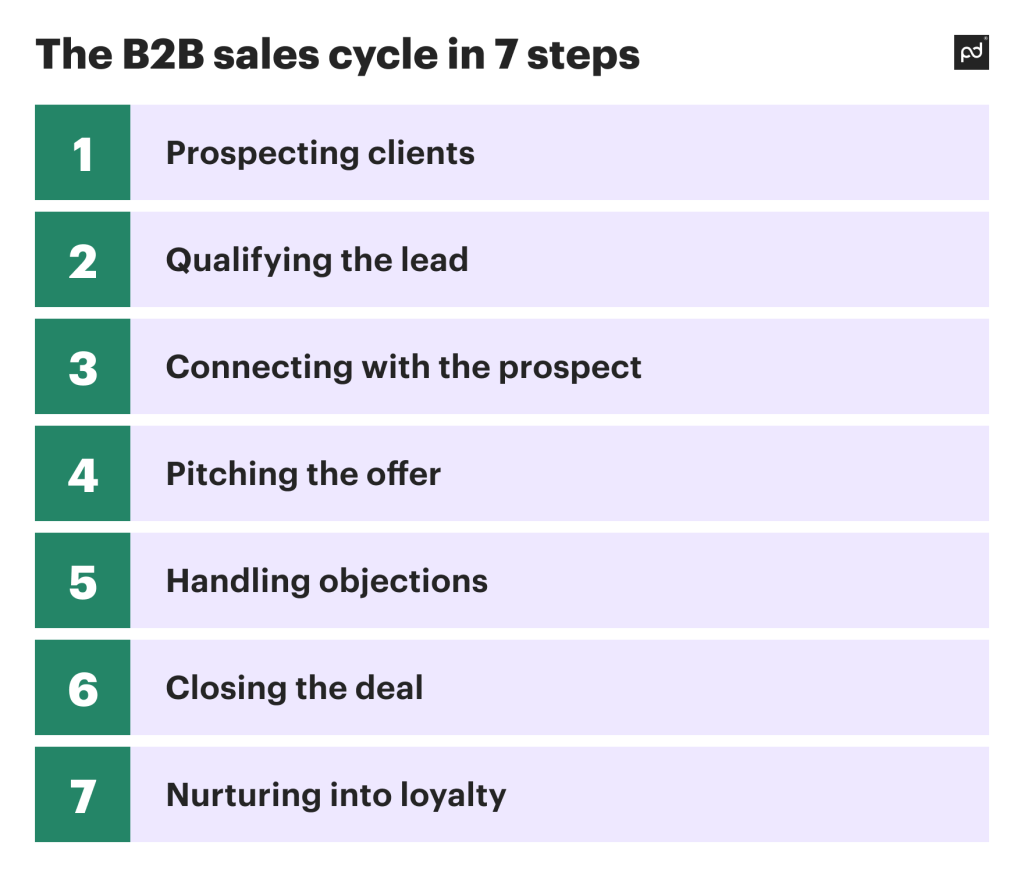
Prospecting clients
Sales prospecting for B2B is similar to — but not the same as — lead generation.
Like lead generation, sales prospecting involves sourcing new leads that have the potential to become paying customers.
However, unlike lead generation’s continuous, one-to-many communication strategy, sales prospecting takes a more immediate, one-to-one approach.
Using inbound and outbound prospecting methods, sales reps can research and identify prospects that match their ideal customer profile (ICP).
They might leverage digital channels, like content and social media marketing.
Or, they might use cold calling or emailing strategies or prospect suitable clients during in-person industry events.
The aim of sales prospecting is to find leads who closely match your ICP.
Your ICP should define the characteristics of your ideal customer: their industry, budget, size, pain points, and goals.
Qualifying the lead
Once you’ve generated suitable leads, it’s time to qualify them.
This involves digging deeper into companies to determine their likelihood of conversion. In doing so, you can identify and prioritize high-quality leads.
Sales reps can qualify leads either in person or via phone or email.
The process involves asking key qualifying questions such as:
- What is your role in the company? This helps sales reps establish the decision-making authority of the individual they contact.
- What is your budget? Ask this question to determine whether the company has the financial viability to become a customer.
- What are your business’s needs, challenges, and goals? This helps you see where your product or service could be positioned as a solution.
- Why is this a priority? Determining the driving force behind the buying process can help you offer prompt solutions to urgent issues, speeding up conversions.
Connecting with the prospect
Through your chosen method of communication, connect with potential customers to grow more familiar with their specific needs, challenges, pain points, and goals.
The aim here is to go beyond the surface level so that you can tailor your offering to meet their unique needs.
Pitching the offer
Of all the B2B sales stages, pitching your product or service is the most make-or-break.
It’s where your sales representatives put together a presentation that showcases what your solution can do for the company.
Every pitch should be tailored to the client’s individual use case.
The features and benefits you communicate should directly align with the prospect’s unique needs and address their pain points.
So, it’s vital that salespeople are armed with in-depth product expertise and extensive customer data before they deliver the pitch.
Handling objections
Clients are bound to have questions and reservations.
Maybe they lack the budget, urgency, or need to invest in your product.
Perhaps they’re worried that your product is too complex or express uncertainty over your solution’s ROI potential.
Whatever the case, salespeople should proactively anticipate these objections.
From there, they can use active listening skills, empathy, and their vast product expertise to build trust and alleviate concerns.
Closing the deal
Closing a sale is the end goal of the sales process.
It’s where you and your client iron out the terms of the sale to eventually reach a contractual agreement.
Activities might include delivering a proposal, negotiating price and payment terms, and drafting a contract.
Nurturing into loyalty
The hard work doesn’t end once you’ve finalized the deal.
Just like B2C selling, you’ll need to onboard new customers to ensure that they extract the maximum value from your product.
You should also nurture customer loyalty through regular follow-ups, personalized content, cross-selling and upselling, and feedback requests.
Top B2B sales strategies and techniques that work
B2B sales techniques aim to help you increase brand awareness, trust, and conversions.
But which ones are the most effective?
Here are three key strategies that every business needs in their B2B sales plan.
Content marketing
More than ever, B2B buyers rely on content to make purchasing decisions.
In fact, B2B content consumption has grown by over 18% in the past year.
The content formats most likely to drive buying decisions include reports, live webinars, how-to guides, and e-books.
So, create compelling, informative content to boost conversions.
Social selling
Use social media platforms like LinkedIn, Instagram, and Facebook to build awareness and relationships.
Along with referrals, social media is the most effective strategy for acquiring high-quality leads.
So, follow your lead’s social media accounts to gain insights into their company and share engaging content on the platforms they’re active on.
Account-based selling (ABS)
ABS is a B2B sales management technique that focuses on identifying and targeting high-value prospects.
This method recognizes the revenue potential of prioritizing accounts that fit the ICP.
Therefore, sales teams can optimize resources and concentrate on offering customized solutions to high-value leads.
6 best B2B sales tips
What else can you do to improve B2B sales performance? Here are six B2B sales best practices:
- Create ideal customer profiles: The more detailed, the better.
- Focus on benefits over features: Customers are more interested in how your product can help them.
- Showcase customer feedback: Encourage and display customer testimonials, case studies, and reviews.
- Arrange face-to-face meetings with decision-makers: In person or via video, try to build rapport with decision-makers through a face-to-face conversation.
- Present companies with options: 58% of B2B buyers want the opportunity to choose between a selection of offerings from a company.
- Provide continuous employee training: Ensure sales teams possess comprehensive product knowledge and are up-to-date with industry trends, challenges, sales techniques, etc.
What are the most important B2B sales metrics?
There are lots of different sales metrics you could track, but which ones are the most important?
Here are the sales metrics and KPIs that you should be keeping an eye on.
- Win rate: How many sales opportunities generate conversions?
- Net profit: This calculates your total profit once all expenses have been deducted.
- Sales pipeline velocity: How long does it take for prospects to move through your sales pipeline? According to the aforementioned HubSpot research, 21% of sales teams say that shortening the sales cycle is a top current priority.
- Average deal size: This metric represents the average amount converted customers spend on your solution.
- Customer acquisition cost (CAC): CAC calculates how much it costs to acquire new customers.
- Sales productivity KPIs: How long does it take your sales reps to hit their targets and move through the sales process? This could refer to things like phone call length or email response times.
- New leads by source: Which channels and campaigns generate the most leads?
Chances are, there are a bunch of other B2B sales metrics that you might find useful.
Other B2B sales examples include sales qualified leads, customer lifetime value, and churn rate.
How important is data in B2B sales?
Data is the key to analyzing the success of your B2B sales strategy.
It gives you concrete information to monitor sales team performance, optimize your sales techniques, and create sales forecasts.
Even more fundamentally, though, data presents in-depth insights into the needs and pain points of your customers.
73% of customers expect companies to understand their unique needs and expectations.
Collecting and analyzing customer data empowers you to identify the needs of high-quality prospects and proactively tailor your offer to meet these needs.
How can technology help with B2B sales?
Technology isn’t just supporting B2B sales — it’s transforming it.
Artificial intelligence. Machine learning. Cloud communications.
In equal measures, these technologies have driven and responded to the cultural shift in the B2B buying experience.
As the process becomes more digital and complex, salespeople can rely on technology to drive operational efficiency, provide better client experiences, and close more sales.
For example:
Sales enablement platforms (SEPs)
Sales enablement platforms (SEPs) centralize your business and customer intelligence data — CRM, content analytics, sales analytics, and more.
This improves visibility, empowering sales reps to deliver speedy, personalized, and continuously improved experiences.
Sales automation tools
Sales automation tools improve efficiency, in turn shortening the sales cycle.
They eliminate repetitive tasks from sales reps’ workflows, enabling them to focus on more meaningful, customer-centric activities.
Automation solutions like PandaDoc natively integrate with your other critical tools, like your CRMs and payment systems, to elevate productivity.
AI-powered cloud communication tools
AI-powered cloud communication tools let salespeople communicate with B2B buyers via phone, SMS, and video.
This opens you up to nationwide and global markets.
Plus, many solutions offer AI-powered features like sentiment analysis, real-time transcriptions, and post-call summaries to enhance the value of conversations.
What B2B sales resources are available?
B2B sales are always evolving, which is why it’s so important to keep up to date with the latest B2B trends.
Luckily, there are plenty of resources available that can teach you how to do B2B sales the right way.
Look online for:
- E-books
- How-to-guides
- Blog articles (there are lots on PandaDoc)
- Webinars
- Educational videos
- Online training courses
What is the future of B2B sales?
As technology advances, the B2B sales process is expected to become even more efficient and data-driven.
For example, AI is set to play an even bigger role.
As B2B buyers turn to AI to perform independent research, we will likely see a fundamental shift in sales reps’ priorities.
Instead of information-sharing, sales reps will perform more active, customer-centric activities.
Salespeople interviewed in HubSpot’s State of Sales report predicted that high-priority activities will include boosting decision-maker trust and confidence, understanding buyer’s unique needs, building rapport, and demonstrating how the product’s capabilities align with the customers’ unique needs.
Also, as B2B buyers continue to use more channels to research and communicate, the reach for B2B companies is on a steady incline.
With machine learning, AI, and automation, B2B companies are set to balance sustainable growth with efficient, streamlined processes.
Speed up your B2B sales deals with PandaDoc’s simple sales doc process
The B2B sales process is a maze of different customer needs, pain points, and touchpoints.
Balancing this with buyer expectations for a speedy, efficient sales cycle isn’t easy.
But automation platforms like PandaDoc can help.
With PandaDoc, you can create professional client-facing proposals and contracts in minutes, improving your close rate by 18%. And that’s not all.
Manage and track your document statuses in real time to drive faster completions.
Enable easy, immediate collaboration between sales reps and buyers.
Use powerful document analytics to track recipient behavior, A/B test your documents and gather the insights you need to improve your engagement rates.
Interested? Check out PandaDoc’s all-in-one document creation, management, and automation platform today in a free 14-day trial.
Disclaimer
PandaDoc is not a law firm, or a substitute for an attorney or law firm. This page is not intended to and does not provide legal advice. Should you have legal questions on the validity of e-signatures or digital signatures and the enforceability thereof, please consult with an attorney or law firm. Use of PandaDoc services are governed by our Terms of Use and Privacy Policy.
